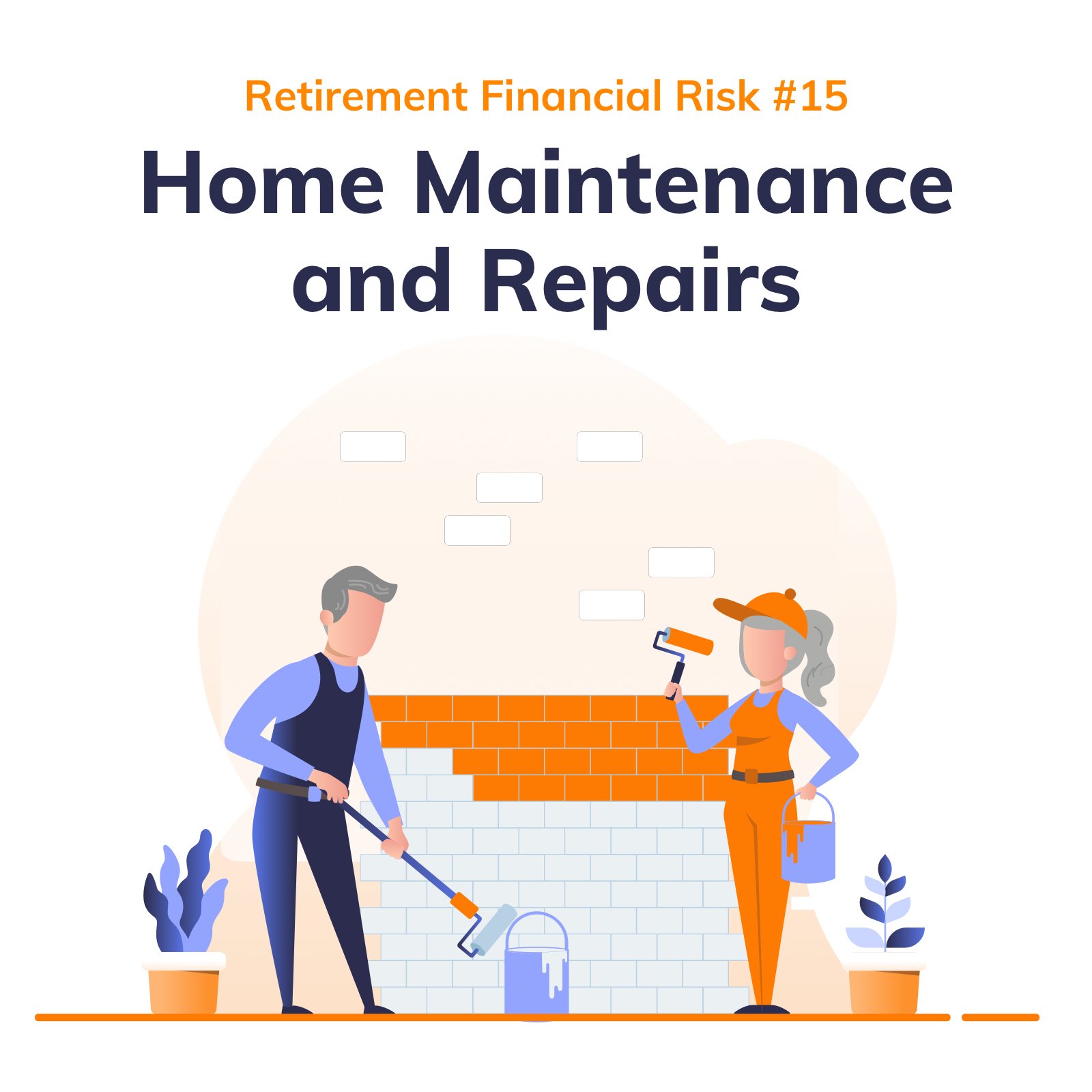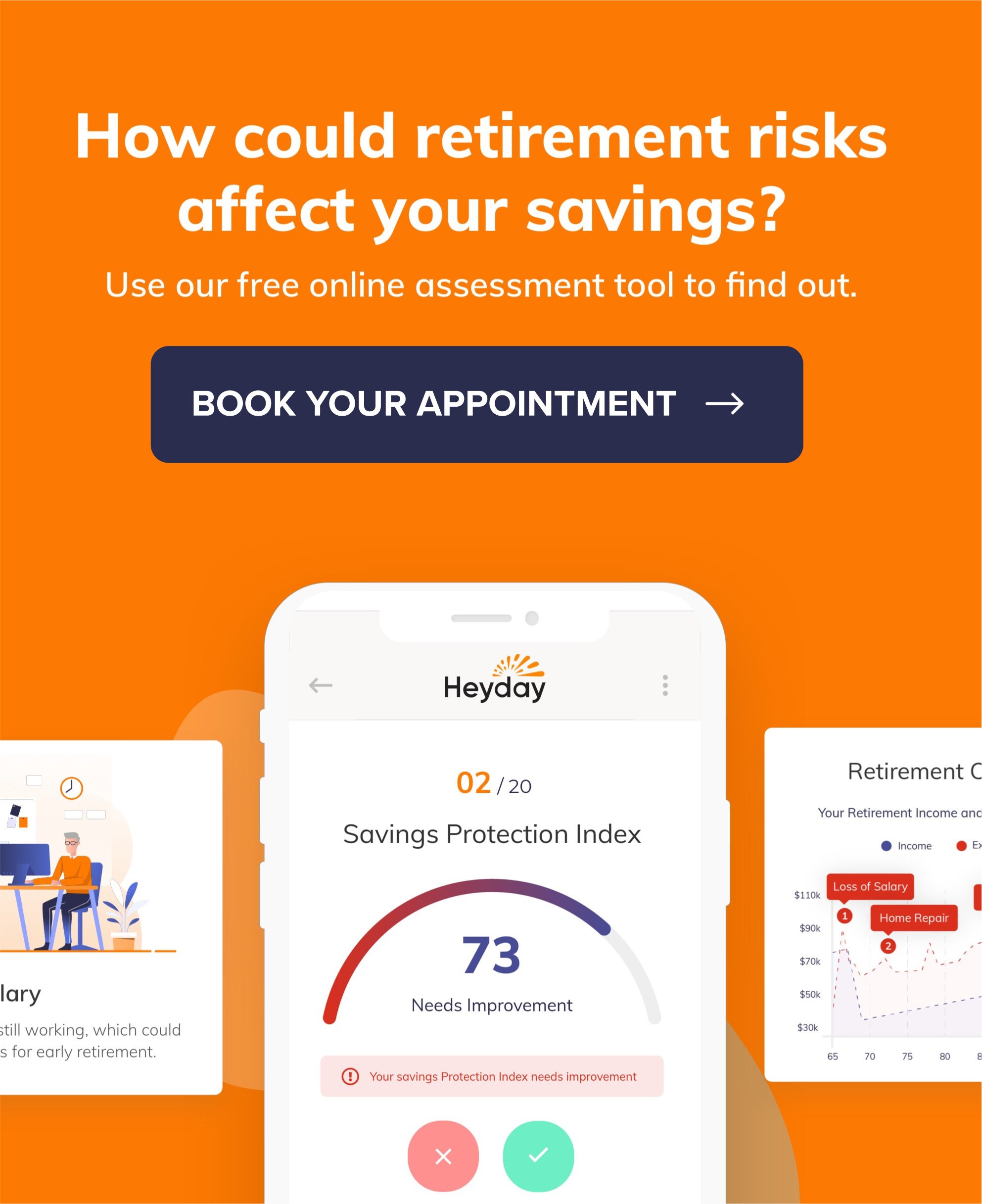Retirement Risk #15: Home Maintenance & Repairs — Plan for Hefty Costs
Even Mortgage-Free Homes Can Cost Retirees Bigtime
Retirees may underestimate how much home maintenance could cost throughout retirement. Even mortgage-free homes can cost several thousand dollars each year. But there are things retirees can do to help prepare now.
According to the Society of Actuaries, financial “shocks” or unplanned expenses can happen multiple times during retirement. One in 5 retirees will experience four or more of these shocks. And 28% of the time, they are home repairs and upgrades.
“Unfortunately, our homes age and need constant maintenance. New roofs, air conditioners, and renovations are just a few of the larger lump-sum costs that should be considered during retirement.”
— Eric Stratton, Heyday founder
Ballpark Estimates for Big-Ticket Home Repairs
Industry experts like Heyday contributor and author, Tom Hegna, recommend retirees plan to age 100 and beyond when it comes to figuring out how long their money should last. Retirees should consider the expected lifespan of major home repairs when budgeting for the long haul.
A New Roof Can Really Add Up
Your roof is most likely the costliest element of your home to replace. Its lifespan can be greatly impacted by the materials used, weather conditions where you live, and in some cases, how well you maintain it.
Here are a few high-level averages and life expectancies of roofs:
HVAC Units May Be Repeat Expenses
If you need to replace your HVAC, it can cost an average of $4,820 - $12,350. Several factors will determine the costs, such as your:
- Total square footage
- The brand and model specified
- Ductwork needs
- Labor costs in your area
With an average lifespan of 12 to 15 years, replacing an HVAC system is an expense some retirees may incur twice.
Don’t Overlook Insurance Deductibles
One home-related expense retirees may not consider until after an event is their home or flood insurance deductible. Home insurance deductibles can range from $500 to over $2,500, while flood insurance deductibles can be double that.
Combined, that could leave retirees with $7,500 they didn’t plan on spending should a flood or storm damage their home.
Home Repairs Can Lead to Hard Choices
According to the 1% rule, homeowners should save at least one percent of their home’s value for home maintenance. So if your home is worth $300,000, you should set aside $3,000 a year.
How can retirees who don’t save up for home maintenance address these situations? Each option presents its own set of potential drawbacks:
Going back to work part-time - depending on health and market conditions, this may not be a viable option. Plus, any increases in income could affect Social Security and Medicare benefits, as well as taxes.
Taking on debt - many experts recommend taking on as little debt in retirement as possible. However, without the funds in savings or another account, retirees may need to take out a home equity loan or use credit cards to get them out of this situation, which could cost more in the long run due to having to pay interest.
Making additional withdrawals to their nest egg - when costly home repairs pop up, many retirees have limited options to handle them. Retirees can typically make additional withdrawals from their retirement accounts but should first consult with a professional about all of the potential consequences. There are many implications to consider before taking this approach — from increased taxes to reduced income later in retirement.
Consider this example:
Frank and Estelle are two years into their retirement. They want to stay in the large custom home they built together 30 years ago. It’s more home than they need, but it’s paid off and a perfect spot to entertain their large family during the holidays.
Frank used to enjoy maintaining the home on his own, but it’s getting more difficult for him to stay on top of the constant maintenance and upkeep. Now they need a new roof, which is estimated to be around $40,000. How could they pay for it?
- Tap into emergency savings - fortunately, they do have $10,000 stashed away for emergencies, but that would only cover a fraction of the cost.
- Use credit cards or take out a loan - borrowing the funds or charging the new roof on a credit card could end up costing them more in the long run, thanks to interest charges. Plus, the more they have to pay in monthly bills, the less they have to enjoy retirement, and $40,000 would likely take several years to pay off.
- Pull more out of retirement savings - Frank and Estelle are only two years into what they hope will be a long retirement. So, taking additional withdrawals so early can limit the longevity of their savings. Plus, they may be subject to additional taxes, depending on which accounts they pull from.
- Go back to work - one or both of them could go back to work to pay for the additional expense after charging it or taking out a loan. However, that could impede on their most active years in retirement. Plus, since they are already drawing Social Security, there are income limits on how much they can make without affecting their monthly benefits.
As you can see, each of these options can have some unpleasant side effects. If the couple had planned for big-ticket home repairs in their retirement strategy, paying for them could have been a lot less painful.
For retirees like Frank and Estelle, costly home repairs are only one risk that could impact their savings. An excellent first step to help pre-retirees and retirees plan is completing an online risk assessment like Heyday’s Custom Retirement Review.
By answering a few simple questions, retirees can see how exposed they — and their savings — may be on the road ahead. Try the free online retirement review here.

Written by Cindy Collins
Forbes Contributor & Retirement Financial Professional
Cindy Collins is a Heyday Retirement contributor with over 30 years of experience in personal financial services.

About Heyday
Heyday is a premier source for comprehensive tools and informative content designed to help retirees build a secure retirement income plan.
Subscribe
Stay in the know on a wide range of retirement topics.









